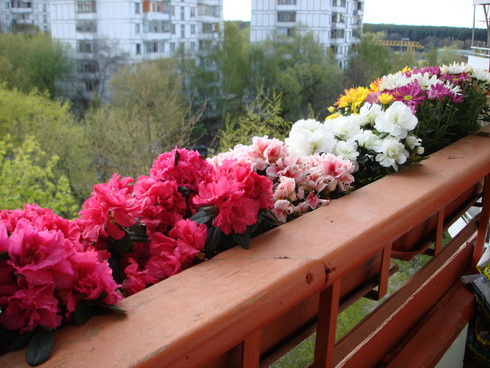|

What to do with the flowers when we are going on vacation?
Summer - is the time of holidays and labour feats in the garden. This is the time of transformation of flower beds, rock gardens, and hunting time for new plants... During this happy period we absolutely forget about the plants remained on the window sills. But if to take care about their destiny before your departure, it is possible to avoid many losses. So, what to do, if you are going to be absent more than a week and it was impossible to find compliant relatives or neighbours who would agree to take care of your flowers. In our disposal there are six ways of water delivery to plants.
The first way
The plants covered with a transparent polyethylene package evaporate much less moisture and can be left under such "cap" for a week. It is also noticed that even, as at full drying of a soil many plants, including gentle ferns, do not fade, being covered with this package. It is better for the package not to concern plants, i.e. it should be big enough big, and thin sticks-props will help to keep it on distance.
The second way
If you leave your apartment for a week or two, take away your plants from the southern window sills, and place the pots in the bigger pots or containers and fill all the emptiness with damp sphagnum or peat. Plentifully water the plants. Cover the surface of the substratum with a polyethylene package. So they can hold on without watering for some time. Tropical ferns and orchids can be transferred to the bathroom and placed on a lattice over the bathroom with water. They will sustain.
The third way
If your absence is longer than two weeks it is necessary to organise an automatic device for water delivery. For this purpose there are some schemes. Some of them you can make by yourself. For example, one end of a wick (old stockings, bandage, and other fabrics) is pushed by tweezers in the drainage aperture of the pot so that to touch the soil and the other end is placed into the capacity with water, placed under the pot. This capacity can be made of any suitable plastic container or a jar. It should be closed by cover with two holes, one for the wick, another for pouring water. This variant is compact, though the similar scheme can be incarnated in other type too. So, the wick can be put on the substratum, and its end immersed in the capacity with water which is placed above the object of watering.
On sale there are now wares with double bottom where the bottom part represents the tank for water. Cords connect water-supplies and substratum. As a whole this system functions by the similar capillary principle.
The fourth way
If the plants large enough or hygrophilous it is possible to place a two-liter large plastic bottle with the holes made in its bottom and cover "headfirst" in the earth to fill it with water. Such "system" will provide plants with water for a long time.
The fifth way
The modern and quite perfect system named «touch system of drop watering». Of course you won’t be able to make such system by yourself but in special stores it costs rather much but this system worth it. Its main element is a ceramic sensor control in the form of a carrot. It is filled with water and inserted into the soil. The soil dries up and the sensor control gives it water. When water-supplies in the sensor control come to end it automatically arrives from the tank through a rubber hose. This system is compact and looks very much civil (unlike the turned plastic bottle), and the main thing is that the plant does not suffer neither from lack of moisture, nor from its overabundance because surplus of a moisture is soaked up in the sensor control.
After some time the calcium contained in tap water clogs up pores of the clay sensor control and it becomes water-proof. Usually its term of service is one season.
The sixth way
The most hi-tech and expensive way when plants are provided with drop watering, operated by timer. Such system in advance needs adjusting and connection to the water pipe. Necessarily test it before the departure. But with this system the plants should not be taken away from the window sills and it is possible to leave for a month or more. And it is only your choice.
|
